 Wisconsin Lawyer
Wisconsin Lawyer
Vol. 79, No.
9, September 2006
Photojournalist Captures Courtroom Reality
Mark Hertzberg, a veteran
award-winning photojournalist, worked on the national and state levels
to open courtrooms to cameras. For nearly 30 years, Hertzberg's lens has
been capturing the realities of the courtroom, engaging and educating
the public about the judicial branch and important social issues.
By Dianne Molvig
Photo: Gregory Shaver - The Journal
Times 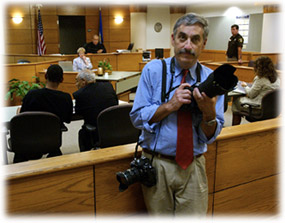
On June 11, 1962, Mark Hertzberg trekked from his home in New York
City to a nearby hotel, where President John Kennedy typically stayed
when he visited the city. Hertzberg figured he might get lucky and
capture a candid photograph of the President.
"I took a snapshot of him with my Brownie," Hertzberg recalls, "and
tried to sell it to Time Magazine." He was 11 years old.
Time declined his photograph.
Scrolling ahead to a day some 40 years and thousands of published
photographs later, we find Hertzberg with a professional Nikon digital
camera focused on the subject of a hearing in a Racine (Wis.) County
courtroom. Hertzberg is there on assignment for the Racine newspaper,
The Journal Times.
Framed in his viewfinder is an 8-year-old boy, just a bit younger
than Hertzberg was on that summer day when he first aspired to be a
published photographer.
This boy, however, is in trouble. Although he's too young to be
formally charged with a crime, he has committed an assault that can't be
ignored. He'd arrived at school armed with a 28-inch-long solid wooden
pole, more than an inch in diameter, that he planned to use against a
student he claimed had beat him up the day before.
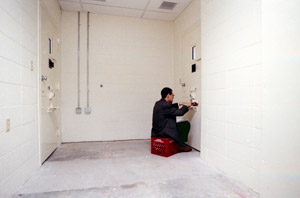
Attorney Domingo Cruz, Racine, meets with a client in the holding
cells in the Racine Law Enforcement Center before the defendant's
initial appearance on Feb. 15, 1999. Hertzberg contends that cameras in
court help to combat misconceptions by showing what judges, attorneys,
and their colleagues really do versus what Hollywood presents.
When he attacked the other child with the pole, the principal
intervened, and the boy bashed the principal over her head, breaking the
pole into three pieces. The principal suffered head injuries and was
nonresponsive when the ambulance arrived. The boy ended up in the
justice system, which ultimately sent him to a residential treatment
facility to learn to manage his anger.
Being in the courtroom to photograph the boy's hearings was
imperative, says Hertzberg, who's been photographing courtroom scenes
since 1978.
"It was an important story to tell beyond the nuts-and-bolts police
blotter stuff," he says. "This was a serious social issue. What happens
to this 8-year-old boy? How does he get treated? What are the
implications for him, for society, for the victim? This case epitomizes
the importance of opening the courts to photographic coverage."
Stories Without Words
It also was an extremely challenging assignment to shoot. "I had to
tell the story," Hertzberg explains, "without ever showing the boy's
face" (to protect his identity).
Hertzberg pulled it off commendably, true to the reputation he's
gained over the years as a photojournalist. One of his photos speaks
volumes about an 8-year-old's perspective on legal proceedings he mostly
doesn't comprehend. The photo shows only the boy's hand as he plays
tic-tac-toe on a legal pad during the hearing.
The last photograph in the series was taken at the end of the final
hearing, when Racine County circuit court judge Charles Constantine
released the boy from residential treatment, allowing him to return home
and continue outpatient treatment. Depicting a typical 8-year-old's
behavior, the photo shows the boy, from behind, waving goodbye to the
judge from the defendant's table. And the judge is waving back.
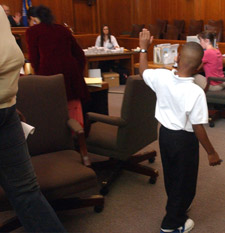
Depicting a typical 8-year-old's behavior and perspective on legal
proceedings he mostly doesn't comprehend, the boy waves good-bye to
Racine County circuit court judge Charles Constantine on July 14, 2005,
after being released from residential treatment and allowed to return
home for the first time since having committed a serious assault. (All
photos by Mark Hertzberg, unless otherwise noted.)
Called "Too Young for the System," the photo series won Hertzberg the
2006 Joseph Costa Award for Courtroom Photography, given by the
Department of Journalism at Ball State University, Muncie, Ind.
He'd won this award before - first in 1987, and then in 2001,
when he became the first photographer to win the award twice. This year
he broke his own record by becoming the first three-time winner. He's
also been the recipient of other awards, among them State Bar of
Wisconsin Golden Gavel Awards.
The Joseph Costa Award has special meaning for Hertzberg because he
knew its namesake personally. Costa was one of the founders of the
National Press Photographers Association in 1946 and a champion for
photojournalists' rights to cover courtroom proceedings.
Hertzberg traces his own awareness about issues surrounding cameras
in courtrooms back to the early 1970s. Fresh out of Lake Forest College,
a small liberal arts college near Chicago, with a degree in
international relations, he got a job at the Beloit Daily
News.
He worked there for four years doing everything from taking
photographs, to writing captions, to writing features and columns -
"journalism boot camp," as Hertzberg describes it.
Two assignments, in particular, at the Beloit Daily News got
him thinking about why cameras should be allowed inside courtrooms. The
first assignment, in 1974, involved covering the trial of a man and his
mother, both accused of maltreating their farm animals. Hertzberg had to
confine his photographic coverage to what went on outside the
courtroom.
"I didn't enjoy photographing a man who was shackled and handcuffed
as he was shuffling from a police car into a courthouse," Hertzberg
recalls. "There was a certain lack of dignity in that."
On another occasion he was covering a hearing at which a wrongfully
convicted man regained his freedom. "I couldn't be in the courtroom to
photograph his and his family's reactions," Hertzberg says. "By the time
they got outside, there was nothing to photograph anymore."
The Wisconsin Experiment
Such experiences motivated him to get in touch with Joseph Costa.
Hertzberg became active in the National Press Photographers Association,
got elected to its board, and served on its Freedom of Information
Committee, which worked on camera-in-the-courtroom issues nationwide.
When the issue came before the Wisconsin Supreme Court, Hertzberg was
there to testify at hearings to support the idea.
Those hearings resulted after Ed Hinshaw from WTMJ-TV in Milwaukee
and Bob Wills, editor of the Milwaukee Sentinel - both acting
on
behalf of the Society of Professional Journalists - petitioned the state
supreme court to allow cameras and audio recorders in Wisconsin
courtrooms. The court agreed to a one-year experiment and then granted
full authorization on July 1, 1979.
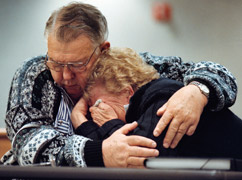
A man who had sexually assaulted two family members comforts his
wife at his sentencing hearing in Racine County felony court on Feb. 19,
2003. In helping to tell a story, Hertzberg reminds his colleagues to
act respectfully because court hearings affect people's lives', they are
not press conferences or photo opportunities.
Hertzberg was eager to jump into action when the experimental period
began on April 1, 1978. "There was a bank robbery trial in Beloit that
day, even though it was a Saturday," he recalls. "So I shot a picture on
the first day."
Since then, he's shot thousands of photographs during his four years
at the Beloit Daily News and 28 years at The Journal
Times
in Racine. But even with all that experience behind him, photographing
in the courtroom "can't be second nature to you," Hertzberg says,
"because if it's second nature, you're going to miss a good
picture."
Besides shooting pictures and acting as The Journal Times'
photography director since 1987, Hertzberg also is media coordinator for
Racine County, a position he's held ever since cameras gained admittance
into Wisconsin's courts in 1978.
"Back then, one of the concerns some judges had," Hertzberg says,
"was that they didn't want to be bogged down with having to make the
arrangements for photographers." Media coordinators - who are
newspaper, radio, or television journalists - handle such
arrangements for their journalist colleagues in their districts.
As a media coordinator, one frustration Hertzberg has is that his
colleagues sometimes lose sight of the fact that being allowed in court
is not only their right, it's also a privilege. "I just try to remind
them that court hearings affect people's lives," he says. "These are not
press conferences or photo opportunities."
When photographers fail to respect the court, Hertzberg feels they
should apologize to court officials. He remembers an incident several
years ago during a Green Bay homicide trial. After the judge announced
the verdict, a local photographer took a picture of the jury - an
action that's expressly forbidden by the Wisconsin Supreme Court's rules
about cameras in courtrooms. The court allows photos of jurors only if
individual jurors give consent or if including jurors in a photo's
background is unavoidable. Even so, those jurors must not be
identifiable.
But the Green Bay newspaper photo clearly revealed jurors'
identities, without their consent. "There was a bit of an uproar,"
Hertzberg says.
He called the photo director at the Green Bay newspaper and advised
him to contact the judge promptly, admit the mistake, and make
assurances it wouldn't happen again. Taking such actions is critical to
the future of courtroom photojournalism, in Hertzberg's view. The
profession must monitor and police itself to maintain credibility.
"When [photojournalists] err," he says, "we have to acknowledge the
error. We can't get defensive. We have to address [problems] head
on."
A Clear Picture
Overall, Hertzberg feels that cameras in the courtroom have gained
widespread acceptance in Wisconsin over the past three decades.
Meanwhile, other states still struggle with the concept. For example,
Indiana recently launched a pilot project to test cameras in some
courts. And in New York, some judges recently have begun to allow still
photography in their courtrooms, creating a small crack in the state's
54-year ban on cameras.
In Wisconsin, one concern that critics raised early on was that
photojournalists would cover only the sensational trials. That type of
coverage will happen "whether cameras are allowed in court or not,"
Hertzberg observes. "Still, in terms of television, I'd rather see 15 or
30 seconds of actual courtroom testimony, rather than a reporter
standing outside a courthouse paraphrasing that testimony."
But Hertzberg sees room for improvement in photojournalism. "There
are a few places where I think we fail as a profession," he says. "One
of them is that our coverage is mostly on the headline felony cases.
There are so many other opportunities to take pictures."
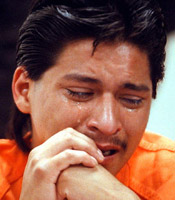
Kris Delgado sobs during his first appearance in Racine County
circuit court, June 25, 1997, on a charge of felony child neglect
causing death.
He'd like to see more coverage of civil court matters, for instance,
or even small claims court. The reality is that budget constraints force
photography directors to make hard choices on not only which proceedings
to cover, but also how much coverage to give any particular
proceeding.
"We don't have a large enough staff to be able to cover a trial full
time," Hertzberg notes, "or to try to guess when different people will
testify." So a photographer might be on hand for the initial appearance
or preliminary hearing and maybe for the verdict and sentencing. "We
rarely send photographers to the body of the trial," Hertzberg
explains.
One exception is a trial in Racine County set for November, involving
a man who shot at four young men attempting to steal cars. The shooter
killed one and wounded another. Both men apparently had been shot from
behind.
"This is the first trial we may staff [with a photographer] full
time," Hertzberg says, "because it's polarized the community. Reactions
range from condemnation of vigilante justice to applause for somebody
who, some would say, 'did what we all want to do.'"
This is another case, like that of the pole-wielding 8-year-old boy,
that raises critical questions for society. And cameras need to be there
to help tell the story, Hertzberg believes.
Despite any flaws or limitations of photojournalism, cameras in court
benefit all of us, he contends, by shedding light on the workings of the
judicial branch of government. "It's the least understood branch," he
says. "One reason is because people don't go to court unless they're
involved in a legal proceeding, and the other is that they're so
brainwashed by Hollywood."
Cameras in court help to combat misconceptions by "presenting to the
public what judges, attorneys, and their colleagues do every day,"
Hertzberg says. "Anything that can be done to bring the reality of the
courtroom to our readers and viewers can only help educate people."
"If cameras were not allowed in court," he adds, "you'd be left with
'Law and Order' and all those other shows as the only window people have
[on the justice system]. And that is a foggy window."
Wisconsin Lawyer
